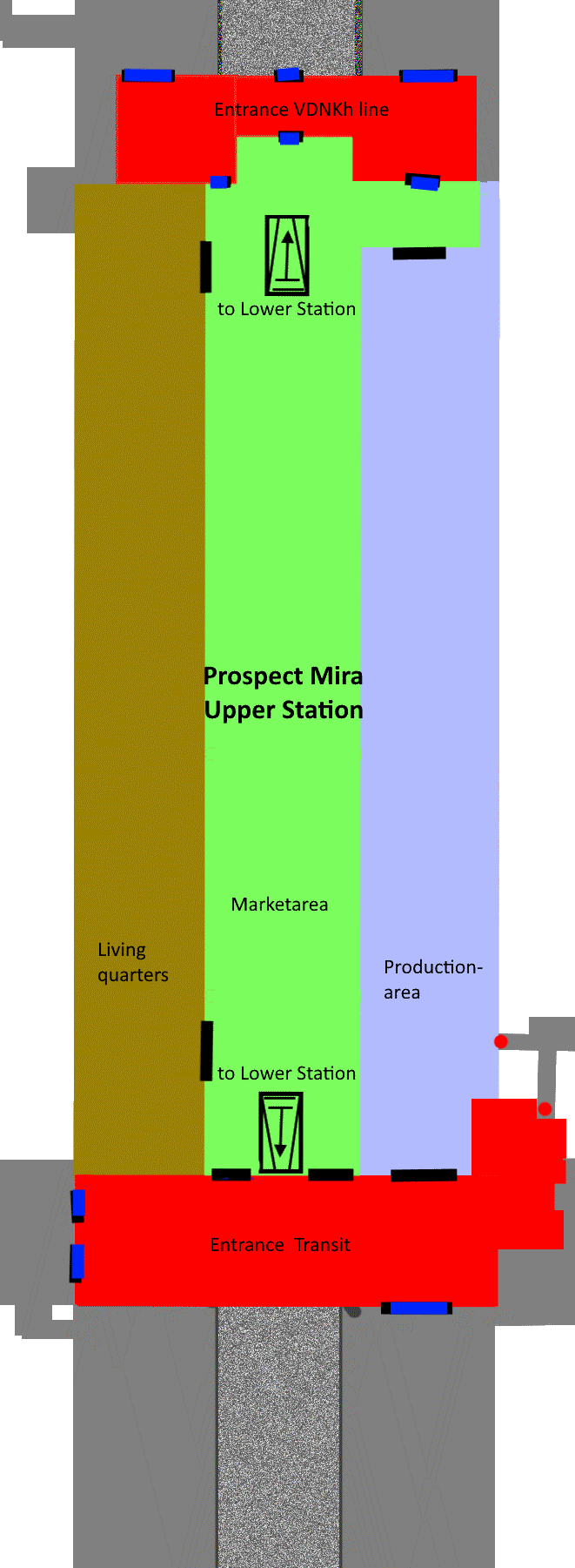"In 2013, a nuclear war forced a large amount of Moscow's surviving population to relocate to the city's Metro system in search of refuge. Eventually, communities settled within the underground train stations and developed into independent states over time. Factions emerged, ranging from the independent peacekeepers the "Rangers of the Order", to the neo-Stalinist "Red Line" faction and the neo-Nazi "Fourth Reich", to the more powerful factions such as "Polis", which contained the greatest military power and the most knowledge of the past, and the "Hanza" regime, which controlled the main ring of metro stations by its sheer economic power.
As these groups began to evolve, the Red Line and the Fourth Reich quickly entered a state of war, as both sought to destroy the other. As the war raged, the stations who refused to join either side were either demolished by the factions, merged into the Hanza regime, raided by criminal bandits, or formed their own independent states. Other stations were outright destroyed by animals, mutated by the nuclear fallout."
Metro 2033 is a Shadowrun supplement to play in the gritty, dark world as imagined by Dmitry Glukhovsky. You will need a copy of the Shadowrun 4E rules to play. Additionally, I recommend to read the Metro novels and/or play the great Metro PC games.
Another great resource for your game is the extensive Metro Wiki.
Overview over the Moscow Metro
For a overview map of th Metro in 2033-2034 click the image on the left to go a detailed version made by Diablerie on Steam Art. The map contains much of the information from the books, PC games and several short stories.
Prospect Mira Station
The starting point of my campaign. The Project Mira station is a Hanza-controlled border station with two subway levels.
The upper level is part of the North-South orientated Kaluzhsko-Rizhskaya line. Miras Northern entrance leads to Riga station which is part of the VDNKh-Commonwealth. There are several old service tunnels on different levels, infested by mutants and bandits, so traveler between Riga and Mira use mainly the Western rail tunnel. The tunnel is powered by electricity and guarded by patrols of both factions. The tracks from the Southern entrance lead to the transit station Sucharevskaya which is little more than a semi-permant settlement for traveling groups. The Southern tunnels are considered dangerous and haunted.
The upper level of Mira station is accessable to everyone who can answer for their purpose the watchful guards. The open market in the main hall is bustling with travelers and refugees passing through, stalkers and merchants trading goods and old tech. The bar is always bursting with patrons. Here one can find food, drink, entertainment, stories and jobs!
So much activity attracts criminal elements operating in small groups. Becareful in quieter parts of the station...
The western platform tunnels are reserved for living quarters, while the eastern platforms are reserved for production facilities.
The lower level of Mira station is part of the Ring line, its Western gates lead to the tunnels to Novoslobodskaya, a prospering Hanza station. The railway tunnels are well-lit and regularily patrolled by Hanza soldiers, travelling on track motor cars or gang cars. The adjacent service tunnels are kept under constant observation to keep the mutant problem at bay.
The Eastern gates lead to Komsomolaskaya, a divided station. The lowere level is controlled by Hanza, the upper level is part of the Red Line. The relation between the two faction is tense, but trade necessities keep things civil, ...for now. There are rumors of Red line spies and agitators within Mira station.
The lower level of Mira station is divided into two main sections separated by the Hanza gate. The Western most part is accessable for Hanza citizens, non-citizens need a temporary passport issued by Hanza authorities. The numerous guards at the Hanza gate check every person thoroughly.
The platform tunnels of the lower station contain mainly Hanza living quarters and some mechanical production facilities. The living quarters are crowed as in all stations, with severel wood-constructed levels within each tunnel to createas much space as possible. The living quarters are mostly separated by wooden walls instead of the more common canvas, clean and well-constructed. The living quarters in the upper level are more similar to the grimier standard normal in most stations.
The living standard is generally quite good at Mira station. There are beggars and shady sites, of course, but everyone has access to water, the station is powered by electricity, a radio channel provide entertainment and information, and working communication lines connect, not only the guard rooms, but also the neighboring stations. Citizens have free access to medical help at the hospital, which is located at the Western Hanza entrance. An additional medical station in the lower public area near the stairway to the upper station, is open to every one for a fee.




